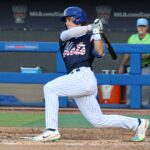
When you select someone in the second round of the MLB Draft, you are looking at someone who is one of the best young players in all of baseball. If that player is a starting pitcher, you expect them to have the stuff to dominate the lower levels of the minor leagues. In reality, you’re looking at that player to perform well throughout each level of the minor leagues en route to a successful major league career.
When a second round pick goes out and posts a 5.10 ERA and a 1.579 WHIP over his first three professional seasons, you know something is wrong. The player knows it better than anyone. Right-handed pitcher Andrew Church told MMN in an exclusive interview exactly what those issues were saying:
“I’d say staying healthy and letting my ego get in the way of pitching smart. On the health part it seemed like every start something didn’t feel right and so it was hard for me to have a repeatable delivery and now after I had the hip surgery following the season in Brooklyn I was able to repeat my delivery every pitch. And on the ego point I think I was so caught up on ‘Hey I can blow this guy away with a fastball’ that I wasn’t looking for holes in his swing or his approach to beat him.”
After the aforementioned hip surgery, Church has been a completely different pitcher. He has become the pitcher the Mets thought they were getting when they drafted him with their 2013 second round pick out of Basic High School in Henderson, Nevada.
He dominated right out of the gate for the Columbia Fireflies. In his first two starts, he allowed only one run, walked no one, and limited opposing batters to a .180 batting average. He got off to this hot start because he was healthy. More importantly, Church got off to this hot start because after three years in the minor leagues, he was learning how to pitch.
With a now healthy hip, Church has a much more repeatable delivery. He throws a low 90s fastball, but he does have the ability to get the pitch into the mid-90s. As we’ve seen with pitchers like Jacob deGrom and Robert Gsellman, the Mets will typically let pitchers like Church sit in the low 90s in the minors, and then in the majors, Dan Warthen has shown the ability to help those pitchers find the extra gear on their fastball.
For now, what is important is Church has a good fastball that he can locate well and use it to get ahead of hitters.
In addition to his fastball, Church throws a good curveball and a developing, promising change-up. Like most Mets minor league pitchers, he is not only working on a slider, he is using it as a real weapon. While he used to try to use this repertoire to try to strike everyone out, Church now has a much more mature approach on the mound. Now, as Church says, “I don’t generally look for strikeouts because I prefer to keep my pitch count down to go deeper into games, but I’d say my slider would be my go to strikeout pitch.”
Just like that Chruch is a throwback pitcher who is a joy to watch on the mound. He gets on the mound, and he works quickly and efficiently. He notices batters weaknesses, he induces soft contact from them, and he keeps the ball on the ground. This permits him to keep his pitch count low and go deep into games.
In fact, on July 16th, Church actually completed The Maddux making him the only pitcher in the Mets organization to do that last year. The Maddux is throwing a complete game shutout while throwing less than 100 pitches.
It is fitting that Church did it last year because he has tried to emulate the Hall of Famer Greg Maddux. Church says he wants to emulate Maddux because, “I like how focused he was and how in tune he was with the game. He could put any of his pitches where he wanted and he was as smart as they come when it comes to reading hitters.”
Last year, Church scratched the surface of what he can be as a pitcher.
Overall, between his time in Columbia, St. Lucie, and Las Vegas, he was 7-4 with a 2.92 ERA, 1.06 WHIP, and a 7.3 K/9. He set career highs in games started, innings pitched, K/9, and WHIP. More importantly, he has figured out who he is as a pitcher, and what he needs to succeed.
Last year, his one appearance with Las Vegas was a reward for a season where he showed tremendous growth. If he continues developing at this rate, he may very well see himself on the mound near his hometown and waiting for a call-up to the majors.















